As you know, infants are susceptible to various kinds of infections, all because their immunity is not strong enough, and therefore can not withstand attacks of pathogens. Let's break down what it is, what it is dangerous for and how to properly treat it without harm to a child’s body.
When many young mothers notice the appearance of white bloom on the tongue and gums of a child, they can take it for leftover milk or food. But unfortunately, often this is a signal of the development of thrush in the mouth.
Thrush in a baby
Many are absolutely sure that thrush in newborns in the tongue has something to do with milk, but this is just a common myth. The disease is caused by yeast-like fungi of the genus Candida.
Normally, these microorganisms live on the skin and mucous membranes of humans and in moderate quantities, they do not cause any harm. But for several reasons, the pathological growth of a fungal infection can occur, and this leads to the development of an illness.
Immunity of any person is responsible for creating beneficial microflora, which strictly controls the number of yeast-like fungi. If we talk about newborns, then they have such microflora at the stage of formation, for this reason, candidiasis is more common in them than in any adult.
The causes of thrush in infants
Although the infant’s immune system is only being formed, with mother’s milk it receives immune cells that provide protective functions. But on the other hand, during breastfeeding, the baby may also get thrush.
What can I say, if you can get candidiasis even with intrauterine development. If a woman has had thrush during pregnancy and has not been treated before giving birth, then passing through the birth canal can easily cause the fetus to become infected with a fungal infection.
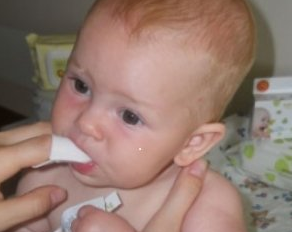
In fact, it is quite simple to “earn” candidiasis; any member of the family can “reward” the child with a fungal infection by touching or kissing. A favorable environment for the development of the disease is a dry and hot climate in the room where the baby is.
The connection here is obvious: a fungal infection in the mouth cavity is suppressed by immune cells and substances that make up saliva. In the case of dry air, saliva also dries out. This leads to the fact that it cannot adequately moisturize the oral mucosa and, as a result, yeast-like fungi begin to multiply uncontrollably.
Other factors provoking the development of the disease include the following:
- frequent regurgitation;
- the presence of small cracks in the mouth;
- immaturity of the mucous membrane;
- taking medication that weaken the immune system, in particular, antibiotics, hormonal drugs.
Statistics show that premature babies often suffer from candidiasis than children born on time. And the children who are on artificial feeding, sick much harder than those who get breastfeeding. It is clear that in both cases the state of immunity plays a leading role, which, with bottle feedingthat prematurely dramatically weakened.
What does a thrush look like?
The main symptoms of thrush in infants are such signs:
- a white patina appears on the mucous membrane of the tongue, gums and cheeks, which eventually turns into spots or plaques;
- the mucous membrane of the mouth becomes inflamed and becomes reddish;
- in the absence of proper treatment, white spots become more and more, and the patina acquires a cheesy consistency;
- the child becomes moody and whiny, and also refuses breast milk. The fact is that sucking the breast causes him pain.
To distinguish the plaque that forms thrush in newborns on the tongue from the usual regurgitation is quite simple. Gently rub the white patter with a dry cloth or handkerchief.
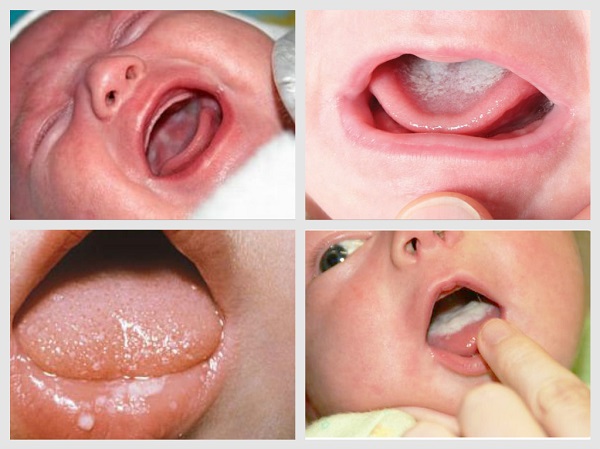
The raid from the food remains is erased easily and leaves no traces. If, however, there is candidiasis, then it will not be so easy to remove the plaque, and red inflammatory traces will remain in its place.
How to treat thrush in the mouth
According to experts, the use of antifungal agents in the treatment of newborns is an extreme measure, especially if it concerns the early stage. The first thing that, in the opinion of doctors, is to do is to maintain a normal, humid indoor climate. This will help special humidifiers, which will constantly monitor the level of humidity, despite the weather outside the window.
If we are talking about advanced forms of oral candidiasis in infants, then without medicinesperhaps not enough. In general, the question of the use of medicines is rather controversial, on the one hand you do not want to “stuff” the child with chemicals, but on the other hand, if you do not stop the fungal infection in time, the problem may develop further in the intestine.
If we talk about girls, then they may even develop candida vagina. In order to prevent the occurrence of such complications, the following recommendations should be followed:
- be sure to show the child to a specialist. A fungal infection could affect not only the mouth, so the doctor must conduct a full examination;
- be sure to conduct a local external therapy, which includes the removal of cheesy plaque and the treatment of inflammatory foci with special solutions and suspensions, which are prescribed by a doctor;
- clean the mucosa with a cotton ball moistened with either a one-percent solution of hydrogen peroxide or soda solution;
- nystatin water suspension will help relieve symptoms of the disease. The tablet should be crushed and diluted in water. Processing takes place every five to six hours;
- if you are breastfeeding, be sure to check for the presence of a fungal infection yourself, perhaps it is you who are the source of the infection;
- with the ineffectiveness of external treatment, as well as in severe cases, antimycotic drugs are prescribed.
In most cases, with timely and proper treatment, the disease retreats within three to ten days. Over time, the child’s immunity will grow stronger and the risk of a relapse will be much less.
Candida from thrush
Medication is effective medicine against oral candidiasis in newborns and the numerous positive reviews of specialists, as well as ordinary buyers, confirm this. The main active ingredient is clotrimazole - a substance that is able to penetrate into the fungi and destroy them.
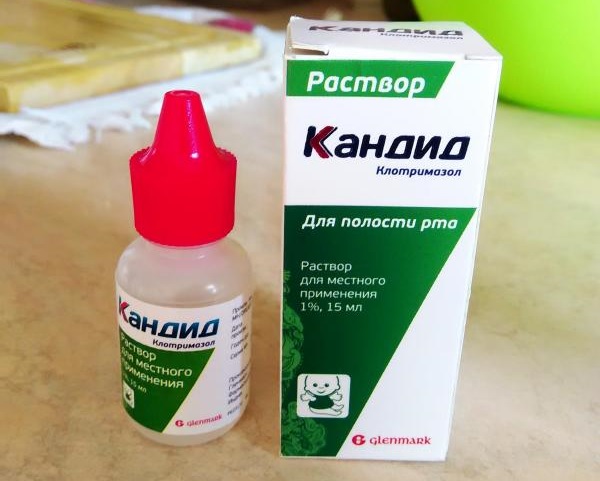
Small doses of Candida slow down the growth of yeast-like fungi, and large doses lead them to complete destruction. This does not mean that you need to give large dosages to your baby, because there are certain treatment regimens according to the age category.
The drug is available in various dosage forms, but the solution is used for the treatment of oral candidiasis. Treatment of the mucous membrane occurs after feeding the child as follows:
- put a few drops of the solution on a cotton swab;
- gently lubricate the inflamed areas of the mouth;
- repeat the procedure two or three times a day.
After a couple of days, you will notice significant changes, but this does not mean that you should stop the treatment. Continue to process the baby’s mouth for a week. And as a prophylaxis mother should also treat her nipples.
The tool is well tolerated by children, but sometimes irritation and burning in the mouth may occur. If the solution gets into the digestive tract, it can cause diarrhea or vomiting.
Candida has its limitations, it should not be used in case of hypersensitivity to clotrimazole. There is no exact information regarding age restrictions, the doctors prescribe a remedy based on their discretion, making a decision in each individual case.
Soda treatment
Soda treatment is a reliable and proven method. As you know, a fungal infection exists and multiplies in an acidic environment, and soda solution alkalizes the environment in the oral cavity, which makes it impossible for further development of yeast-like fungi.
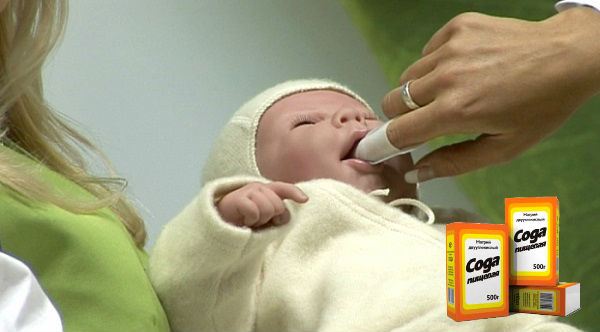
To prepare a two-percent solution, you need to take one dessert spoon of baking soda and dilute it in two hundred milliliters (cup) of boiled water. For four days every three hours, treat the oral mucosa.
Sometimes they use honey. It is necessary to mix a teaspoon of honey with three teaspoons of water, and dip it in a solution.
ethnoscience
As a treatment of the oral cavity of the newborn, you can use the following folk remedies:
- decoction of calendula flowers;
- oak bark;
- chamomile flowers;
- sage herbs;
- aloe juice;
- sea buckthorn oil.
It is necessary to brew the solution, according to the instructions, drain and allow to cool to 30-40 degrees. Usually a mini pulverizer is used to spray infected areas of the mouth. Well suited cotton swab or bandage dipped in solution.
Procedures are carried out daily for 8-10 days, 3-4 times daily. In any case, the use of medicinal herbs, consult with your doctor, although herbal solutions are very rarely harmful.
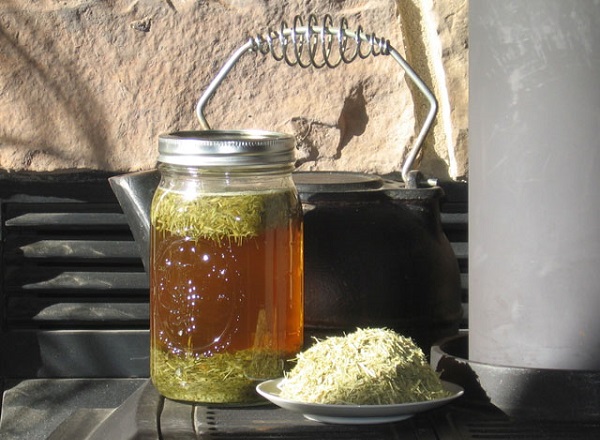
There are many controversial methods, for example, carrot juice is often used, but there is no confirmed data regarding its antifungal properties. And some recipes sometimes horrify, for example, some mothers smear the affected egg mucous membrane of the child’s mouth mucosa. But this can lead to infection with salmonellosis and the development of severe allergic reactions. That is why it is important to always consult with a specialist.
Possible complications of children's thrush
Despite the many methods of dealing with infant thrush, this disease is classified as dangerous and can lead to the development of such complications:
- candidal sepsis;
- severe damage to internal organs;
- weight loss;
- dehydration;
- in premature babies, the disease can even be fatal.
Prevention
In order to prevent the occurrence of the disease, follow these guidelines:
- in order to prevent intrauterine infection with thrush, promptly treat the development of the disease during pregnancy and be sure to undergo a second course of treatment before giving birth;
- keep your hands and nipples clean;
- after each feeding treat nipples with a weak soda solution;
- wash and sterilize baby’s nipples and bottles after each use;
- monitor the purity of the skin and mouth of the newborn;
- to normalize acid balance and flush breast milk after each feeding, give the baby some boiled water;
- strengthen the child’s immune system, massages and hardening can help.
So, children's thrush is not such a harmless disease, as it may seem at first glance. But on the other hand, timely and competent treatment will help get rid of the disease. Do not self-medicate; you will only lose precious time and aggravate the situation. Entrust the health of your baby to your professional
Yesterday your beloved baby was cheerful and lively, with pleasure sucked milk, played, smiled. And today he is naughty, refuses to take a breast or a bottle, crying. Look crumbs in her mouth. Did you see a strange whitish bloom on the tongue? This is a sign of a fairly common disease in newborns - thrush. It is not worth much to be afraid of this, with timely treatment the plaque passes quickly.
We wrote about white bloom in the language of a newborn earlier (), this is a normal natural phenomenon, but if white “plaques” similar to cottage cheese appear in your mouth, you need to react in time, and now we will show in detail how to identify thrush and talk about how to treat it.
What is thrush?
From Wikipedia: Candidiasis (mamma) is one of the types of fungal infection, caused by microscopic yeast-like fungi of the genus Candida (Candida albicans)
Symptoms of infant thrush
The main symptom - the child appears white bloom in the mouth. Spots or "plaques" appear on the mucous membranes of the mouth: on the tongue, palate, gums, inside of the cheeks, around which small inflammation is often formed. When removing the plaque under it will appear red (as opposed to the usual milk plaque on the tongue).
The child may be restless, capricious, throwing breasts during feeding or even refuse from the breast (bottle), as sucking can cause him pain. After some time, small spots grow to the formation of large light films or creative bloom.
Scrape the white bloom with a teaspoon. Did you manage to remove the curdled pieces? In their place were red sore spots? Your child has thrush, or thrush.
Thrush is a fairly common disease that is caused by a particular fungus, Candida. These fungi are present in every person, without causing him harm. However, when the baby’s immunity is weakened and the mother’s hygiene rules are not followed, fungi begin to multiply rapidly. As already written, in the mouth of the newborn, on the tongue, on the mucous membrane, a white coating appears on the surface of the cheeks, similar to curdled milk (hence the name of the disease). But, unlike milk residues, it is quite difficult to remove it with a napkin or a cotton swab.
The main difference between thrush and traces of milk in the infant's mouth is that milk residues disappear some time after feeding. White spots of thrush more and more "crawl" on the mouth and tongue of the crumbs, causing pain.
(See photo: this is how thrush looks in the mouth and in the tongue of newborns)
 thrush tongue thrush mouth
thrush tongue thrush mouth
Causes
- Fungus Candida albicansevery person has an adult and a newborn. Do babies during teething (By the way, here's another that may occur during teething), at cold, dysbacteriosis, the immunity weakens, conditions for active growth of the fungus appear (you may be interested to read about);
- If the mother does not comply with the standards of hygiene (keeping the mammary glands clean, boiling bottles and nipples, as well as baby’s toys), the prerequisites for the development of the disease are created;
- Candida fungi love sweets, so sweetened water or a mixture contributes to their rapid reproduction;
- If the mother of the child is sick with thrush, the baby is at a high risk of becoming infected;
- Taking antibiotics can also trigger the development of thrush.
If a disease occurs, find out the cause of the infection so that after treatment the crumb does not re-catch thrush again.
What is the danger of the disease
When the thrush gets sick in the baby's mouth, a thick, rough patina appears, under which inflamed spots are found. In case of severe damage, the spots may even bleed. There is a high probability that a more serious infection will penetrate into the infant’s body.
When running thrush spots of plaque form a dense film, which tightens the entire oral cavity and goes to the inner surface of the throat of the infant. The gums and lips become cracked, start to bleed. Sucking and swallowing movements deliver baby severe pain. The child is worried, screaming, refuses to take the breast or nipple, he may have a fever.
(see how plaque can spread)
How to treat thrush
Having found cheesy stains in the mouth of the infant, do not panic. Thrush in newborns responds well to treatment. The main thing is to regularly carry out the necessary procedures until complete recovery.
It is necessary to show a sick child to a child therapist. Depending on the degree of development of the disease, he will prescribe treatment. This is usually medication based nystatin.
But it happens that visiting a doctor right away is not possible. After all, a child may fall ill at weekends when clinics do not work. It is permissible to begin treatment and relieve the condition of the baby on their own.
Soda treatment
Honey treatment
A more palatable procedure for infants is the lubrication of the oral cavity with honey solution (for 1 teaspoon of honey - 2 teaspoons of boiled water). Of course, if this sweet medicine is not contraindicated in a child and the child is not allergic to honey. Honey has antimicrobial properties, it quickly and painlessly removes harmful fungi. The processing frequency is the same as soda, up to five times a day.
Some tips:
After feeding, pacifier, before giving it to the crumbs, rinse in any of these solutions.
It is advisable to boil all the toys that a child can pull in his mouth. (Nipples and bottles need to boil constantly)
Together with the baby, the course of treatment must also be passed on to the mother. Before each feeding and after it, be sure to rinse your breasts with soda or honey solution.
With proper care and timely treatment after 3 to 4 days, signs of thrush disappear. But the course of treatment prescribed by the doctor must be completed to not cause the return of the disease.
Prevention
The greatest risk of developing thrush in newborns lasts up to six months. After all, the child's body is actively growing and developing, and the immature immunity is still weakly resistant to disease. Therefore, it is so important to follow the simple rules to avoid this unpleasant disease.
- Rinse the breast thoroughly before you attach the baby to it;
- Having finished to feed the baby, let him drink warm boiled water. It will wash away the milk residues in the mouth. If the kid burped, suggest him to drink some water;
- Observe personal hygiene, wash your hands often;
- Try to prevent re-infection of the child with thrush. Regularly boil bottles, nipples, pacifiers, toys, i.e., all objects surrounding the crumbs. If it is impossible to sterilize, treat the items with soda.
We treat mouth thrush according to Komarovsky
As you can see, curing thrush is not so difficult. Although it is much easier to prevent its development. Compliance with simple preventive measures, careful observation of the child's condition will help to avoid many problems, to preserve and strengthen the health of infants.
Thrush genitals in children
Although we are talking about thrush that develops in a child’s mouth, it is necessary to know that there is another form of thrush in children (found in girls) - vulvitis. Most often, this disease occurs after swimming in polluted water. A sign of the disease is redness in the genital area of the girl. It is necessary to show the child to the therapist or pediatric gynecologist; in this case it is impossible to engage in independent treatment. The consequence of this dangerous disease may be fusion of the labia. (we will write a separate article for you)
Often parents notice that a child has a strange white bloom in the mouth, and the baby refuses to breast and is worried. So candidiasis, or thrush. People who do not encounter such a disease may think that thrush in infants is directly related to the feeding process and mother's milk. In fact, the cause of thrush in newborns is completely different.
The main culprits of candidiasis are fungi of the genus Candida, which in normal conditions constantly live in the human body. And only the uncontrolled and active reproduction of the colonies of this fungus can lead to symptoms of candidiasis. Thrush in the tongue in infants is a frequent occurrence; one should not think that candidiasis affects only the genitals.
Thrush in the tongue of a child most often occurs in newborns and babies under one year old; older children rarely suffer from such a disease. The reasons why there is candidiasis in newborns are as follows:
- Diseases that can reduce the immunity of the child, resulting in saliva loses its protective properties;
- Poor washing of bottles and nipples, poor-quality sterilization or lack thereof;
- Transfer of candidiasis from the mother during childbirth or breastfeeding, or in other ways from family members suffering from candidiasis and not maintaining proper hygiene;
- Candidiasis in girls may indicate infection still inside the womb of the mother, as well as diseases of various organs and systems;
- Regular regurgitation may contribute to the appearance of candidiasis;
- Candidiasis is more likely in premature babies and in bottle-fed babies.
In addition to the above reasons, stains on the tongue and in the oral cavity from thrush in babies can appear because:
- Taking antibiotics and other drugs that can reduce the body's natural defenses;
- Close contact with another child suffering from candidiasis, in which they can pull into the mouth the same toy or drink from the same cup;
- Your child has diabetes, intestinal problems, tonsillitis, or bronchitis;
- Too much sugar in the baby’s diet, such as sweet milk formula;
- Scratches and sores in the mouth;
- Caries, gingivitis and other problems with the mouth and teeth.
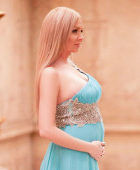
Symptoms of candidiasis in children
The following symptoms of thrush in the baby’s mouth can be distinguished:
- White spots in the mouth and on the tongue;
- The child becomes restless, does not want to suck the breast or the nipple, often regurgitates;
- Because of the defeat of the gastrointestinal tract, diaper dermatitis can accompany the thrush in the mouth of a newborn, which is expressed in the form of diaper rash around the anus and on the buttocks;
- Perhaps a combination of candidiasis in the mouth and other parts of the body, in the folds of the skin and on the genitals.
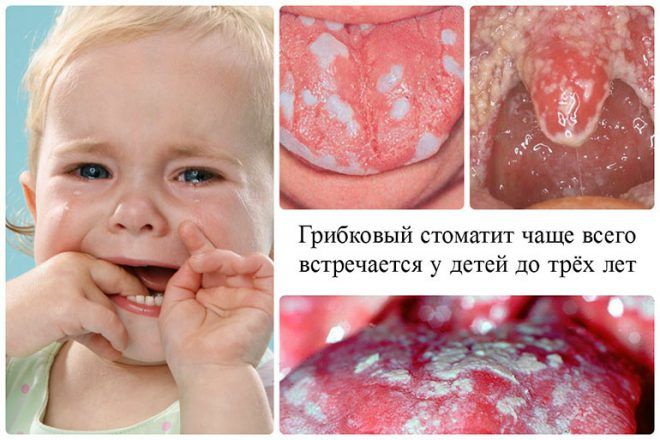
There are three severity of candidiasis in children:
- The first stage of candidiasis occurs easily, the child does not feel any particular discomfort, there is a white patina in the mouth of the infant, which is easily removed;
- In the second stage of candidiasis, white plaque in the mouth of the child takes on the appearance of a curd mass, under which bleeding wounds are found, which cause the baby pain and make him refuse to eat;
- The third stage is characterized by abundant proliferation of plaques that cover the entire oral cavity, tongue, palate, lips and back wall of the pharynx, it is impossible to remove white spots due to the dense soldering with the mucous membrane. A child may have a fever, problems with intestinal microflora, lymph nodes increase.

If symptoms of severe stage are observed, the child is sluggish and refuses to feed, losing weight, you should immediately consult a doctor. Left untreated thrush of newborns in the mouth can lead to the following serious consequences:
- Fungal lesions of the internal organs;
- Sepsis;
- Dehydration and weight loss due to not eating.
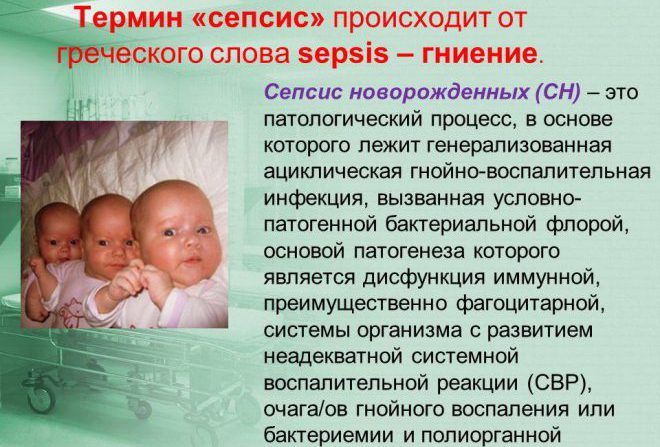
Treatment of candidiasis in children
The answer to the question of how to treat thrush in infants lies primarily in the removal of the underlying causes that led to the development of candidiasis. Often candidiasis may appear due to too dry air in the apartment, as a result of which the mucous membrane of the mouth dries out, which allows the fungus of the Candida genus to multiply and cause thrush, therefore the air must be sufficiently moist. If the cause of thrush in excessive sugar content in the diet of the child, it is necessary to reduce the use of sweet mixes.
If candidiasis has not passed into a severe stage, then local treatment of thrush with the use of disinfectants is applied. Mainly used two percent soda solution, which are processed plaques in the child’s mouth starting with the cheeks, then the tongue and lips. To do this, wind gauze on your finger, and then wet it in a solution and wipe the accumulation of white spots.
If the child is already more than six months old, the doctor may prescribe antifungal drugs, for example:
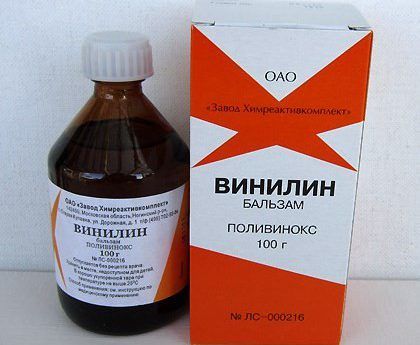
Ointments should be applied dotted with a cotton swab, and the amount of the preparation used should be carefully monitored.
In the event that the mother of the child is breastfeeding, it is necessary to wash the breast after each feeding, and then treat each nipple with soda solution to prevent infection. In addition, all bottles and toys of a child that he can pull into his mouth must be carefully processed and boiled.
Severe candidiasis in most cases is difficult to cure with the above remedies, since it requires serious inpatient treatment.
Treatment of folk remedies
"In secret"
Have you ever suffered from problems with your menstrual cycle? Judging by the fact that you are currently reading this text - the problems still bother you. And you know well what is:
- copious or scanty clots;
- pain in the chest and lower back;
- unpleasant smell;
- discomfort when urinating.
Perhaps it is more correct to treat not the effect, but the cause? The interview with the chief gynecologist Leyla Adamova has finally been published, now every reader can get acquainted with him and learn how to prevent the disease.
Many mummies noticed a white blot on the tongue or mucous membrane of their cheeks in their children. At the same time the child became capricious and refused to eat. Typically, these symptoms are a sign of thrush.
Thrush in infancy - this is a frequent occurrence, which is well docked with proper treatment, without causing serious consequences.
Symptoms
Not always the symptoms of thrush can be identified the first time. Often parents confuse it with the usual patina that occurs after feeding the child with artificial milk formula. To determine the presence of thrush can be on specific grounds:
- raid has a cheesy character and hardly removed from the mucous membranes;
- when removing it exposed hyperemic areas of the mucousthat may bleed;
- the appearance of a raid is accompanied by irritability and tearfulness the child, since the affected lesions are characterized by severe pain;
- kid refuses to eat;
- as the inflammation increases, the plaque gradually covers the entire surface of the mouthforming a thin film. It further extends to the lips and larynx;
- the disease is accompanied violation of stool and fever.
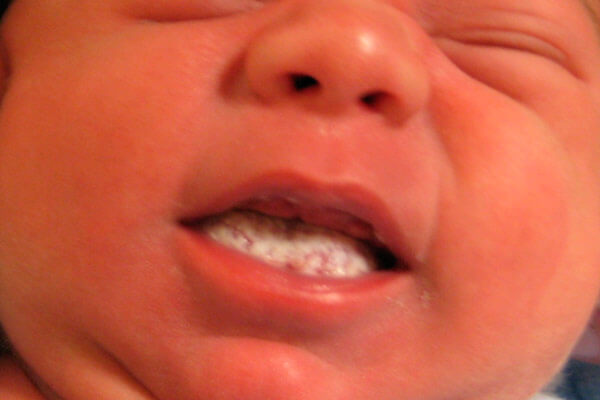
The reasons
The cause of thrush is a fungus of the family Candida. It is found in every human body and activates with reduced immune function. Since immunity in infants is not yet fully formed, the fungus, getting into his body, quickly begins to multiply, leading to the appearance of thrush.
There are several options for infecting a baby:
- during childbirthwhen a child becomes infected with urogenital candidiasis, passing through the birth canal;
- airborne.
There are several factors that provoke the development of the disease:
- dysbacteriosis;
- antibiotic prescription;
- oral acidosis;
- acute respiratory infection;
- allergy;
- frequent regurgitation;
- regular non-compliance with hygiene by the mother: licking soothers, using unsterilized bottles, etc.
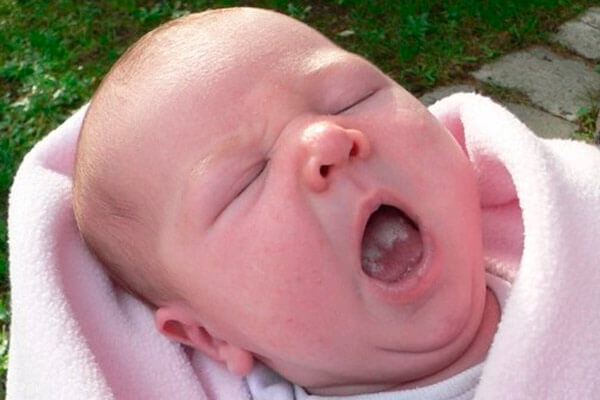
Stages
For thrush, as well as for any other diseases of the oral cavity, it is characteristic gradual developmentwhich includes 3 stages:
- Easy It is characterized by the appearance on the mucous membrane of small rare specks of red color, which are then covered with a white film. In this form, the disease does not cause discomfort in the child and is well treatable.
- Average. The affected areas become covered with a cheesy bulky bloom and become painful. Bleeding ulcers appear.
- Heavy Dense plaque covers the entire oral cavity and spreads to the larynx, the symptoms of intoxication intensify. In-patient treatment is required at this stage.
Forms
This disease is characterized by two forms of manifestation: acute and chronic.
Acute form It is characterized by the sprinkling of the oral mucosa, cheesy plaque consisting of fungi, dead epithelium and food degradation products. With the development of the acute form increases the area of sprinkling and the density of plaque.
As a rule, the pathology is accompanied by excessive dryness of the mucous membrane and the appearance of cracks in the corners lips With timely treatment to the doctor, the acute form responds well to treatment.
The chronic form of this pathology proceeds a little differently. Appear on the mucous small inflamed foci roundish, which are covered with yellow or brown bloom. The affected area has a marked hardening and elevation above healthy tissue.
These sites with palpation give pain. Further observed swelling of the entire mucosa and hardening of the lymph nodes. This form requires long and serious treatment.
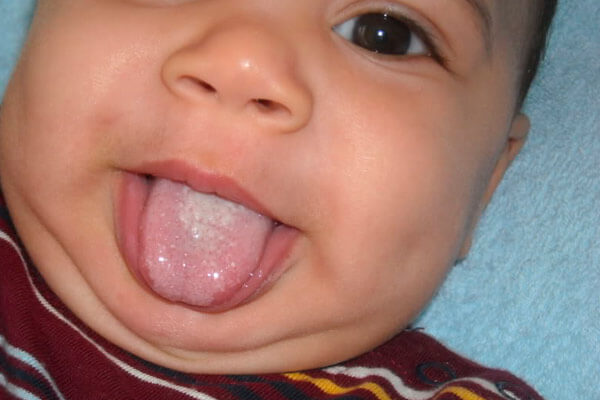
Help
The peculiarity of the treatment of thrush in infants is that for this age it is impossible to use most of the drugs and agents effective against Candida fungi. Therefore, therapy should be prescribed only by a doctor. This applies not only local or general treatment, but also the use of folk methods.
Local Therapy
Topical therapy is the most preferred option for treating thrush in infancy. It does not have a general negative effect on the body, but it effectively fights the symptoms and the cause of the disease. Basically for the local treatment using the following means:
- Weakly diluted solution of potassium permanganate. Applied to the treatment of the baby's mouth at least 5 times a day. To do this, the finger is wrapped with a bandage and moistened in solution, after which the whole mucosa is treated, paying attention to the inflamed areas.
Potassium permanganate has aseptic properties that stop the growth of fungi.
- Nystatin ointmentwhich has antifungal effects. It is used to treat the inflamed areas at least 2 times a day.
- Holisal. This gel is recommended for anesthesia of the mucous membrane, in addition, it has anti-inflammatory effect. After applying the drug begins to act within 2 minutes. Most often it is used to facilitate the feeding process.
- Aqueous solution of 1% tannin. It is used to disinfect the mucous by applying to the affected area. For infants solution can not be applied for more than 5 days.
After each treatment, iodinol, gentian violet or lugol must be applied to the mucosa. The treatment is repeated every 3 hours.
- Levorine suspension, having antifungal effect. It is prepared independently, grinding a tablet for 100 thousand units. and fill it with 5 ml of boiled water. Suspension process the entire oral cavity every 6 hours. This tool can be replaced by a suspension of pimafucin.
- Kanesten in the form of a solution. It has a pronounced antifungal activity. It is used for the treatment of the mucous no more than 3 times a day.
![]()
General therapy
As a rule, general therapy in infancy is prescribed only when the thrush is running or its chronic form, when local preparations have not had the desired effect. The following antifungal drugs are allowed as a general treatment in this age period:
- Fluconazole or its derivatives: diflazon, diflucan. With pronounced symptoms on the first day, a single dose is prescribed in a dosage calculated from 6 mg of the drug per 1 kg of child's weight.
On the following days, the dosage is halved. To facilitate the introduction of his funds mixed with milk or water. On average, the treatment period is from 3 to 5 days.
- Amphotericin B. Available in powder form, from which the suspension is prepared. It is indicated for the treatment of children from a year, but under the supervision of a physician can be used at a younger age.
The dosage is determined depending on the weight of the child: no more than 75 U of the preparation should be taken per 1 kg. The tool is taken 1 time per day for 3 days.
- Flucytosine. It is a powder used to prepare a suspension, which can be used to treat thrush from the moment of birth. The average daily dose is 100 mg per kg. The course of treatment lasts about 7 days.
Folk recipes
To alleviate the symptoms of the disease and use traditional methods of treatment. But before using them, it is necessary to consult with a specialist. The most popular products are:
- baking soda solution, which is prepared as follows: in a glass of boiled water at room temperature diluted with a teaspoon of soda. The resulting mixture is treated 5 times a day with inflamed mucosa;
- decoction of a mixture of medicinal plants: bark of oak, calendula, chamomile, sage. A tablespoon of each plant is poured with a glass of boiling water and allowed to cool.
When treating the mouth, it is necessary to use a small amount of liquid to prevent swallowing, since these plants can cause allergies;
- raspberry juice paste and honey. For its preparation it is necessary to take both components in an equal volume and boil 3 times. The cooled mixture is applied to the foci of inflammation.
Despite the fact that this recipe has become widespread, doctors do not advise using it, because raspberry juice contains acid, which leads to additional irritation of the mucous membranes.
In addition, honey is an excellent nutrient medium for pathogenic bacteria, the reproduction of which only worsens the overall clinical picture.
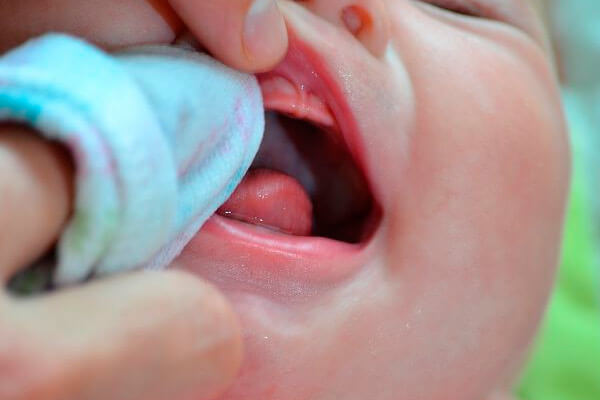
Possible complications
If untreated, the infection can penetrate into other tissues or organs and cause a number of complications:
- intestinal dysbiosis and abnormality of the stomach;
- diseases of ENT organs: sinusitis, rhinitis, otitis;
- defeat genitourinary system in girlsin which vulvovaginitis or fusion of the vagina may develop;
- airway pathologywhich quickly become chronic: bronchitis, asthma;
- sepsiswhich occurs when an infection enters the blood or lymph system.
Valuable advice about the considered disease gives Dr. Komarovsky this video:
Prevention
In order to avoid the development of thrush in infants, moms need to follow certain rules:
- when breastfeeding is necessary before applying the baby to the breast wash with boiled water;
- after feeding or regurgitation is necessary give the child a drinkto wash off food particles and neutralize the acidic environment;
- before engaging with babies, you must wash your hands;
- should not be given to a child unwashed toys and pacifier. At least once a day they must be boiled or treated with soapy water;
- recommended regularly process all items babydesigned to power or play, aseptic solutions or soda;
- preferably once a day clean the baby’s mouth with moist gauzeworn on the finger;
- can't give baby medicine unchecked and unsuitable for the age of the baby products.
Your baby began to act up and eat badly, and did a white bloom appear on the mucous of his mouth? Most likely, this is thrush or candidiasis (Candida albicans), that is, a fungal disease that affects 20–40% of infants in the first months of life. But do not panic! If you start treatment on time, the consequences can be avoided, and the child will recover within 1-2 weeks.
What is dangerous thrush in children?
Why is it necessary to urgently show the infant to the doctor at the first symptoms of thrush?
Because this disease can only be manifestation of something more serious which requires prompt and qualified treatment.
What other dangers await a sick child with candidosis?
- Under the whitish spots on the oral mucosa are inflamed areas that sometimes bleed and contribute to the penetration of infection into the body.
- Plaque in the mouth can "go" further and spread to the throat and even the esophagus. This will give the child pain when swallowing, then he will refuse to eat.
- Since this is a fungal disease, it easily spreads to everything that crumbles in the mouth. If the child is accustomed to sucking on a finger, then the fungus will soon appear on small nails.
- Through clothes and diapers, the disease is often transferred to the skin. If the baby suffers from diaper dermatitis, and its delicate skin is irritated, it is most likely that these places will be affected. And genital candidiasis, transferred in early childhood, can affect reproductive function.
- We should not forget about the mother who feeds the child. Through the chest, thrush easily passes to the woman, so there is a risk of mastitis.
- If no action is taken at all, the Candida albicans fungus will cause more serious consequences, or the disease will become chronic.
Why a child may have thrush: causes
In fact, the main reason for the appearance of candidiasis in children is a reduced immunity. But in itself, it cannot fall; 2 groups of factors contribute to this: endogenous factors (or internal) and exogenous factors (or external).
Endogenous factors
- Prematurity of the child and the related underdevelopment of some systems.
- Hypovitaminosis.
- Congenital chronic eating disorders.
- Metabolic disease.
- Endocrine disorders.
- Dysbacteriosis.
- Frequent regurgitation.
Exogenous factors
- Infection through contact with the surrounding people with people with foci of Candida albicans on the skin (these can be relatives, and the medical staff of the maternity hospital or clinic).
- Intrauterine infection or infection during passage through the birth canal, if during pregnancy a woman had a fungal infection of the vagina.
- Infection from the mother through milk or through the nipples after birth.
- Artificial feeding, in which the baby does not receive a sufficient amount of protective antibodies contained in breast milk.
- Any antibiotic effect. And it is not necessary that the drugs were given to the child himself. Treatment with antibiotics of a nursing mother also contributes to the occurrence of thrush.
- Mechanical injury of the oral mucosa.
There is a risk that the picture will be even more aggravated if the room where the baby is constantly located is too dry and hot. Such a climate causes drying up of the oral mucosa, which, in turn, becomes an excellent “base” for the appearance and development of the fungus.
IMPORTANT! If a child cries often and is in a hot room at the same time, he will most likely soon have the first signs of thrush. Therefore, it is important to moisten the air and calm the baby.
What does thrush look like in the mouth of babies: symptoms and signs of illness
Unfortunately, it is not so easy to distinguish traces of the use of milk by a baby from a dangerous fungal plaque. But you still need to regularly examine the mucous membrane of the infant’s mouth in order to detect the disease at an early, mild stage. There are three of them.
Easy stage
- Red dots or specks that quickly become covered with white cheesy bloom.
- Located plaque on the inside of the cheeks and tongue.
- White spots are easily removed with a cotton-gauze pad.
- Under the white layer, there are minor reddenings that do not bleed.
- Sour smell from crumbs.
- Lack of discomfort when sucking and swallowing.
- At this stage, the baby still does not bother, so he will not react to the fungus.
Middle Stage or Moderate
- Separate white spots begin to grow in size, interconnect and form a continuous film on the mucous membrane.
- The very layer of plaque becomes more dense, like a thick curd.
- It is already removed with difficulty and not everywhere, bleeding foci remain under the white layer.
- The child's temperature rises (to about 38 °).
- Thrush affects the entire inner side of the cheeks, tongue and even the lips of the baby.
- Since at this stage the bloom begins to strongly affect the taste and cause discomfort when sucking and swallowing, the baby becomes moody, screams and refuses to eat.
Heavy stage
- A dense curd layer on the mucous begins to spread to the sky, gums and throat.
- The color of the plaque may become yellowish or grayish.
- The temperature rises to 39 °.
- To remove the white layer completely is no longer possible at any site, as it is tightly connected to the mucous surface.
- The child becomes very sluggish, naughty all the time, even when not eating.
- Symptoms of dysbiosis may occur.
- With such a form you should not try to cope on your own, as you can only worsen the situation. Severe thrush is often treated in a hospital.
How to treat thrush in a child - effective remedies for the disease
What will be the treatment of thrush depends on the stage of the disease. Doctors do not recommend giving the child some antifungal medications at an easy stage, but this does not mean that the baby should not be shown to the doctor.
If the parents have even the slightest suspicion that Candida albicans develops in their crumbs, then before going to the pediatrician you should do the following:
- check the humidity and temperature in the room where the child is most of the time: the temperature should be 19-24 °, and the humidity 40-60%;
- ensure that the infant breathes through the nose, not the mouth, otherwise the mucous will be overdried;
- prevent long crying - it also dries the mouth.
Drug treatment
Drug treatment of oral candidiasis is usually prescribed when the situation is already running. In these cases, doctors recommend some medications.
Miramistin
It is produced in the form of a solution or ointment. For children, it is better to choose a solution that is applied to a cotton-gauze swab and wipe the oral mucosa in the areas of lesion. This drug is good because it has no taste and smell, and does not cause tingling.
Nystatin
As a rule, the doctor prescribes pills from which you can easily prepare a suspension, dissolving the drug in water. The resulting solution is wiped the place where there is a white patina, every 5 hours. Lavorin is also used in the same way. Nystatin has one significant disadvantage - sometimes it causes an allergic reaction.
Candide
This drug is prescribed quite often in the form of ointment. It is applied with a thin layer no more than 2 times a day. Despite the fact that the effect will be visible in 2-3 days, the treatment can be prescribed for quite a long time.
Pimafucin
2.5% suspension process the affected areas with cotton swabs. This should be done 2-3 times a day.
So that the treatment with antifungal drugs does not affect the baby’s immunity, he is sometimes prescribed a course of vitamins in drops or multivitamin complexes for the nursing mother.
Do not forget that there are certain things in the house that a baby takes in its mouth: toys, a pacifier, a bottle, etc. They will need to be thoroughly washed and treated with antifungal agents.
Folk remedies
Folk remedies to treat oral candidiasis in infants is possible only if you have consulted a doctor. Otherwise there is a risk that your actions will harm the crumbs. However, in the mild stage of the disease, even before going to the pediatrician, some time tested remedies are resorted to.
Soda
Take 1 tsp. baking soda for 1 cup of boiled water. When everything dissolves, you need to take a piece of a wide bandage, wrap it around your finger, moisten it with a solution and gently wipe the mouth mucosa and tongue of the crumbs.
Medicinal herbs
The most effective infusions are obtained from chamomile, calendula, sage, camelite and eucalyptus. 1 tbsp. l herbs pour a glass of boiling water, insist for half an hour and filter. Cotton swab moistened in a solution and wipe the mucous membrane in places of damage.
Carrot juice
If the baby has already turned 4 weeks old, then he can be given 15 minutes before feeding 1 drop of fresh carrot juice. But be careful: carrots often cause allergies, so at the first sign of it, immediately stop giving juice to the baby.
Honey
Perhaps such a tool like the baby more, because it is sweet to the taste. It is diluted with boiled water in a ratio of 1: 2. Wipe the same as soda solution. But honey is also a strong allergen.
Boiled turnip juice + honey
For 1 glass of juice, take 1 tsp. honey and mix thoroughly. The resulting mixture must first wash away the bloom, and then process the remaining wounds with a fresh swab.
Flax seeds + honey
1 tsp. seeds should be poured 100 ml of boiling water and let it brew for an hour. Then to the mixture was added 1 tsp. honey, stirred, moistened swab and process the mucous.
ATTENTION!
All recipes where there is honey can be applied only in the absence of allergy to honey and after the recommendation of the doctor.
When the baby will undergo a course of treatment, we must not forget about the hygiene of all households, especially nursing mothers. She should also be tested and, if Candida albicans is found in her, she also needs treatment.